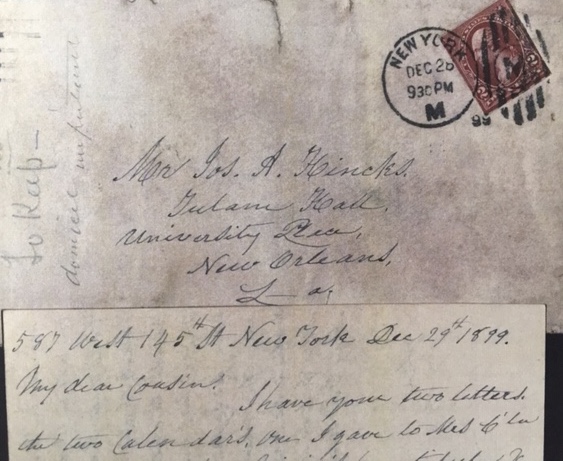Correspondents: Communities Created & Honored in the Letters

Josephine Louise Newcomb kept up a steady correspondence with many people in the years 1871 to her death in 1901. As for all people of her time, letters offered the only chance to communicate with people over great distances. The letters show that she was part of a number of different national and regional communities. In New Orleans, the College was her logical and primary community, but she also knew people from the fourteen or so years that she lived in the city. In New York, the communities to which she belonged centered on the Episcopal Church, friends and acquaintances with whom she stayed long periods of time, and others who worked either for her or with her.
She wrote affectionately to friends and family as well as to servants, bellmen, and others. She addressed them Dear friend, My dear cousin, My dear Col. Johnston, My dear Louisa. She wrote to answer their queries and to ask them for information, thus showing the network of her world especially between New Orleans and New York. In New Orleans, she entered into the life of the College, choosing the rugs for a memorial room, and other furnishings. She thanked people for their news too of the College. She wrote to introduce people, as well as to tell about her own activities and health, and to join them as she offered advice often in the form of religious counseling, or references to poetry. She wrote to offer compassion, to check on sick relatives, to find if she could help.
She also frequently mentioned other friends and relatives in her letters, as well as some she feared. Letter-writing allowed her to tell her side of the family feud with her sister and her nieces and nephews.
Knowing something of the people to whom JLN wrote and knowing something of the people of whom she wrote, both, allow insight into her biography. This section tells of those people.
The first section, the one you are now reading, generally addresses the communities created around letters. This is the same point being made here, that sharing even brief correspondence was important to JLN particularly because she moved around (rarely staying in one place more than a few months) and depended on letter-writing to keep her anchored to various people. Letters enabled her to move through and beyond grief, especially over the death of her daughter and her fear of her sister’s family.
Another section gives brief biographies of the twelve recipients of letters in the McConnell family papers. These people were forward-looking, interested in, and active for, a variety of causes.
Finally a third section identifies other friends and relatives in her letters, many of whom were also recipients of letters printed in the court cases. These others important to her life also include members of her family, especially her sister Ellen, to whom many of the most interesting and loving letters in the court case volumes are addressed, thus making their schism all the sadder.



